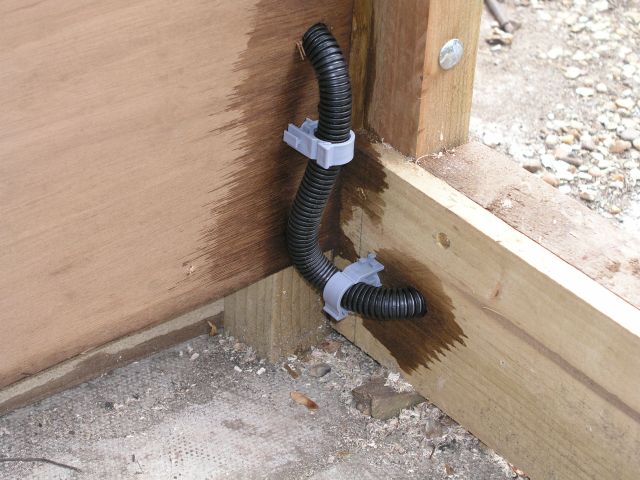

Fortunately I already had mains electricity nearby. I originally ran power down the garden to operate a submersible pump in my pond, and I extended it into my compost area when I bought an electric shredder. The cable was enclosed in flexible conduit, purchased from the garden centre where I bought the pump (which came with 20 metres of cable) and who sold the conduit off a roll. I estimated I needed 9 metres to take the cable from the power point to the observatory. I went back to the garden centre to find that they don't sell it any more. An employee assured me that Wickes sold it and they do—in 5-metre lengths! What use is that in the garden? Eventually I found it in the Toolstation catalogue in 10-metre lengths together with ten end fixings (which I didn't need). This was enough for me, but would not be for anyone building a pond. The conduit is 20 mm in diameter, but could I buy 20-mm clips to secure it? No! The garden centre used to sell them, but of course they don't now. I ended up with 22-mm pipe clips from the plumbing section. They are closed clips that helps to hold the conduit in place despite its being a little loose. Cable is expensive and I discovered when I built the pond that it can be cheaper bought as an extension cable (I remember that at the time I bought 50 metres on a reel with two sockets and a plug for a lot less than 40 metres off the reel). It didn't seem to be true for the shorter length I needed this year, until I found a ten-metre extension cable using arctic cable from Toolstation. The cable is good to -40°C—not that we ever get temperatures that low but it was cheaper than the standard cable. Threading the cable through the conduit can be difficult. I tried several ways when I made the pond and found that the following worked, and I used it again here. I laid out he conduit on the lawn as straight as I could, securing one end with a brick. I tied a length of thin, nylon string to a 5-inch nail and drew it through the conduit with a magnet. (I have some ring magnets from old televisions from the days when they used magnetic focusing. They were powerful by the standards of 50 years ago, but I'm sure you can get much more powerful ones these days.) The nylon string will then pull the cable through. I choose nylon string because, pull it as hard as I can, I cannot break it. If I have to remove the cable from the pump in the pond, I have to pull it through in situ, 20 metres with all the bends involved. I have to tie the cable to the string very carefully and bind over the join with tape to make a smooth connection and I have even had to cover it with grease to get it through. I didn't go to so much trouble this time but had to lay out the conduit fairly straight to get the cable through, and then put the conduit in its final position with the cable already through it. On the whole with outside wiring, I prefer that the conduit is on the surface where it can be seen and I only bury it where I have to—in this case under the path into our compost area. As far as the observatory is concerned the cable comes in from under the end of the roll-off section and I have secured it along the side gravel board close under the lower rail, it then loops through the board and then through the end support timber to the inside underneath the table, then it runs up to a board secured to the wall behind the desk and into a double-pole, fused switch before being routed to standard sockets. This arrangement of power has a unique problem. The pump in the pond is controlled by a time switch in the house. Of course this turns off the whole supply to the garden, including my observatory, and is normally off at night. There are switches in the garden which enable me to turn off individual items separately, so I can put the observatory on with the pump off, but it will be an extra nuisance. What I plan to do is to continue to drive everything off the battery, just as I have in the past with the tripod, and to recharge this during the day when the power comes on.

Here you see the conduit where it comes through the gravel board and loops up and into the observatory. You can also see the clips. I treated the holes with Cuprinol, and, when I took this picture, I had not given the panel its cosmetic coat to even up the colour.
You can see how the conduit routes inside the building in the top picture on my furniture page,.
18th October 2009

The conduit comes in under the desk and runs up through one corner of the desk and finishes behind a board made from 12-mm ply. The cable enters the switch, which is a double-pole isolation switch with a built-in fuse which enables me to turn off everything in one place. The cable then goes down to the two standard power sockets where I can plug in anything I need.
18th October 2009